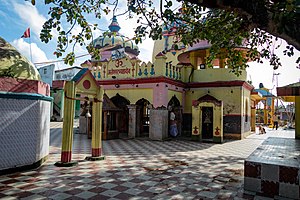|
Mahottari District
Mahottari District (Nepali: महोत्तरी जिल्ला, ⓘ), a part of Madhesh Province, is one of the seventy-seven districts of Nepal. The district, with Jaleshwar as its district headquarters, covers an area of 1,002 km2 (387 sq mi) and had a population of 553,481 in 2001, 627,580 in 2011 and 705,838 in 2021 census.[1] Its headquarters is located in Jaleshwar, a neighbouring town of the historical city of Janakpur. The name Jaleshwar means 'God in Water'. One can find a famous temple of Lord Shiva in Water there. Jaleshwar lies at a few kilometres distance from the Nepal-India border and has a majority Maithili population. Geography and climate
Demographics
At the time of the 2011 Nepal census, Mahottari District had a population of 627,580. As their first language, 81.0% spoke Maithili, 7.3% Urdu, 5.4% Nepali, 1.9% Magar, 1.4% Tamang, 1.1% Tharu, 0.9% Magahi, 0.2% Hindi, 0.2% Newar 0.1% Bhojpuri and 0.1% other languages.[4] The ethnic makeup of the region is very diverse. 15.2% were Yadav, 13.4% Musalman, 6.5% Dhanuk, 5.8% Koiri/Kushwaha, 5.1% Terai Brahmin, 4.1% Teli, 3.7% Musahar, 3.6% Chamar/Harijan/Ram, 2.5% Khatwe, 2.4% Dusadh/Paswan/Pasi, 2.4% Sudhi, 2.3% Magar, 2.2% Nuniya, 1.8% Hill Brahmin, 1.6% Baraee, 1.6% Chhetri, 1.6% Tatma/Tatwa, 1.6% Tharu, 1.5% Bin, 1.5% Kalwar, 1.5% Tamang, 1.4% Mallaha, 1.3% Hajam/Thakur, 1.3% Sonar, 1.1% Kanu, 1.1% Kewat, 1.0% Dhobi, 0.9% Kurmi, 0.9% Lohar, 0.8% Halwai, 0.7% Kami, 0.7% Newar, 0.7% Rajput, 0.6% Dhunia, 0.6% Kumhar, 0.5% Kathabaniyan, 0.4% Bantar/Sardar, 0.4% Danuwar, 0.4% Kayastha, 0.4% other Terai, 0.3% Damai/Dholi, 0.3% Mali, 0.2% Badhaee, 0.2% Dom, 0.2% Gaderi/Bhedihar, 0.2% Gharti/Bhujel, 0.2% Kumal, 0.2% Sanyasi/Dasnami, 0.1% Amat, 0.1% Majhi, 0.1% Punjabi/Sikh, 0.1% Rai, 0.1% Sarki, 0.1% Sunuwar, 0.1% Thakuri and 0.2% others.[5] Religion: 84.2% were Hindu, 13.3% Muslim, 2.0% Buddhist, 0.1% Christian and 0.2% others.[6] Literacy: 46.2% could read and write, 2.5% could only read and 50.9% could neither read nor write.[7] Notable peopleList ordered alphabetically
AdministrationThe district consists of ten urban municipalities and five rural municipalities. These are as follows:[8]
Former Village Development Committees (VDCs) and Municipalities The 2011 National Population and Housing Census by the government of Nepal identifies 77 municipalities and village development committees (VDC) within the Mahottari District.[9]
See alsoExternal linksWikimedia Commons has media related to Mahottari District.
References
|
|||||||||||||||||||||||||||||||||||||||||||||||||||||||||||||||||||||||||||


